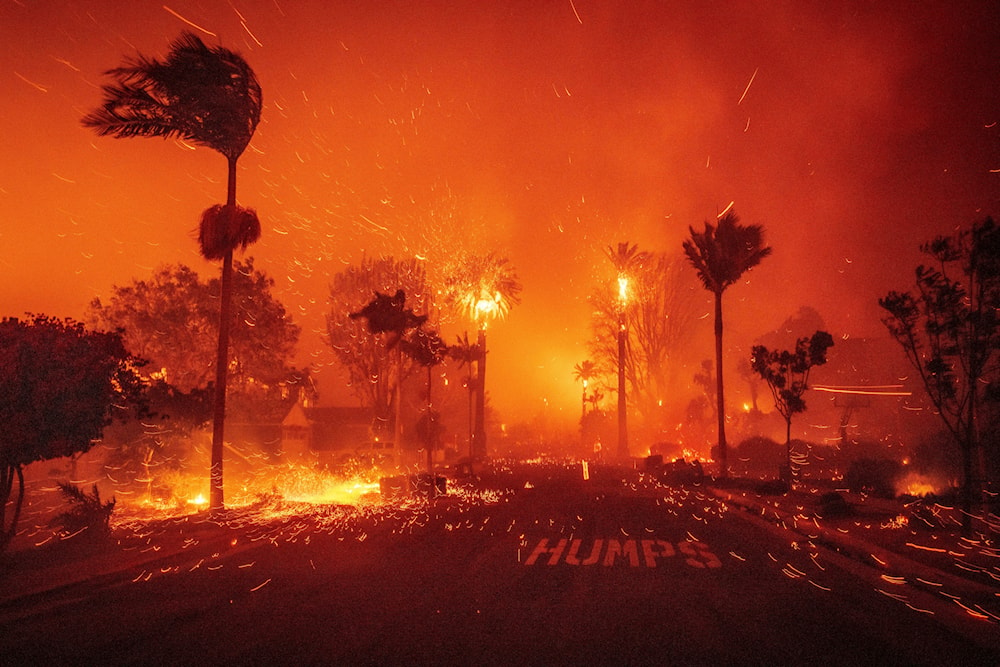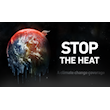Climate whiplash: Extreme weather patterns disrupt major global cities
Over the past two decades, dozens of cities, including Madrid, Riyadh, and Lucknow, have undergone a climate flip, transitioning from dry to wet conditions or vice versa.
-

The Palisades Fire ravages a neighborhood amid high winds in the Pacific Palisades neighborhood of Los Angeles, January 7, 2025. (AP)
From Dallas to Shanghai, major global cities are experiencing dramatic shifts between dry and wet extremes, a phenomenon researchers call climate whiplash. A new study reveals that this pattern is already causing devastating consequences as the intensifying climate crisis disrupts water systems, displaces communities, and spreads disease.
Over the past two decades, dozens of cities, including Madrid, Riyadh, and Lucknow, have undergone a climate flip, transitioning from dry to wet conditions or vice versa. Researchers analyzed 112 major cities and found that 95% exhibit a clear trend toward either drying or increased rainfall.
The consequences of these shifts are severe. Cities already struggling with inadequate water infrastructure, such as Karachi and Khartoum, are among the hardest hit. While regions like Europe, the Arabian Peninsula, and much of the US are drying out, cities in South and Southeast Asia are experiencing intensified rainfall.
The study underscores the profound disruptions caused by human-driven global heating. Water-related disasters account for 90% of climate catastrophes, affecting more than 4.4 billion urban dwellers worldwide. Rising temperatures exacerbate both droughts and floods—warmer air absorbs more moisture, intensifying dry spells while fueling extreme downpours.
Dive deeper
Professor Katerina Michaelides from the University of Bristol told The Guardian, "Our study shows that climate change is dramatically different around the world." Her co-author, Professor Michael Singer of Cardiff University, described the unpredictable global shifts as ‘global weirding’. "Most places we looked at are changing in some way, but in ways that are not always predictable," he noted.
The challenge of adapting to these rapid shifts is immense. Many cities already struggle with water supply, sewage, and flood protection, and global heating is further straining outdated infrastructure. The problem is particularly acute in low-income nations, where extreme weather makes it harder to develop essential systems.
In Nairobi, one of the cities experiencing climate whiplash, residents have faced alternating years of extreme drought and devastating floods. "People were struggling with no water, failed crops, dead livestock… Then the next thing that happens is too much rain, and everything’s flooded… water gets contaminated, and then people get sick," Michaelides explained.
The analysis found that 17 cities worldwide, including Jakarta, Dallas, Baghdad, and Melbourne, have been hit hardest by climate whiplash, experiencing extreme fluctuations between wet and dry periods. The sharpest climate flips were recorded in Cairo, Madrid, and Riyadh, while cities like Lucknow, Bogotá, and Tehran saw dramatic shifts toward wetter conditions.
The study also identified the most vulnerable cities—those facing increasing climate risks while having the least capacity to adapt. Topping this list are Khartoum, Faisalabad, and Amman. Karachi, another high-risk city, has seen more extreme rainfall, with devastating consequences. "We have spent many days and nights completely drenched in rain because we had no shelter," said Karachi resident Mohammad Yunis. "The weather affects everything… Our localities are breaking down."
Even in cities where changes have been less dramatic, long-term trends are clear. Paris, Los Angeles, Cape Town, and Rio de Janeiro are getting drier, while cities like Mumbai, Lahore, and Kabul are becoming wetter.
These findings align with the most recent Intergovernmental Panel on Climate Change (IPCC) report, which warns that even small increases in global temperatures will amplify climate extremes. "A few tenths of a degree warmer and the life we know becomes increasingly at risk due to climate extremes such as heatwaves, droughts, and heavy rainfall," said Professor Sonia Seneviratne of ETH Zurich.
Singer hopes this study will spark global action. "Perhaps it will lead to a more realistic conversation about supporting adaptation to climate change, with a sense of compassion and understanding of the challenges people are facing, rather than just saying, well, we can’t afford it."
Methodology
Researchers used the Standardized Precipitation Evapotranspiration Index (SPEI) to analyze climate trends from 1983 to 2023. Cities were classified as experiencing a climate flip if they had at least 12 more months of one extreme (wet or dry) and 12 fewer months of the opposite extreme in the last two decades. Those with at least five additional months of both extreme wet and extreme dry conditions were labeled as experiencing climate whiplash.
Population data was based on urban density rather than administrative boundaries, providing a more accurate representation of city size. Social vulnerability was measured using the Human Development Index, while water and waste infrastructure data came from a global dataset published in 2022.

 5 Min Read
5 Min Read









